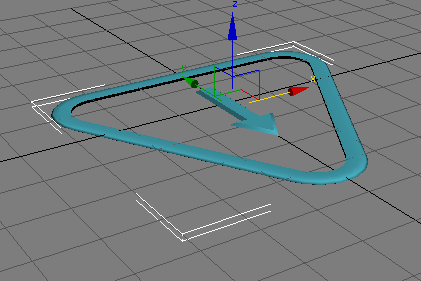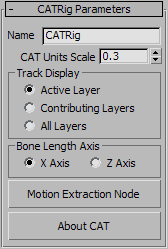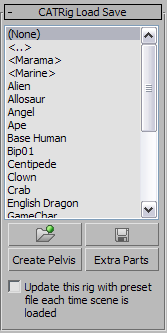Create panel > Helpers category > Choose CAT Objects from the drop-down list > CATRig Load Save rollout > Add a CATRig to the scene.
Every CATRig has one CATParent. The CATParent, which is the triangle+arrow symbol seen under each rig as it is created, can be considered the character node of the rig.

CATParent with no rig
All of the elements of the rig are associated with the CATParent. It holds basic information about the whole rig, including its name, size and other basic data.
It also holds the Rig Preset Manager, which allows you to load and save CATRig presets.
The rig is not linked to the CATParent but can be transformed by it when in Setup mode. The rig inherits scale transforms from the CATParent in both Setup and Animation modes.

 Open the Create panel and
click the Helpers button.
Open the Create panel and
click the Helpers button.

Shows and lets you edit the name 3ds Max CAT uses to prefix all bones in the CATRig. See Using 3ds Max CAT's Naming System.
Defines a units system for this CATRig. All size parameters on the CATRig that define such things as bone length width and height are in CATUnits. See Understanding CATUnits.
Choose the method 3ds Max CAT uses for displaying the layers and keyframes on this CATRig in Track View. See Track Display Modes.
Choose the axis (X or Z) that the CATRig uses as the length axis. See Understanding the Bone Length Axis.
Toggles the Motion Extraction Node.
The CATRig Load Save rollout displays a list of existing CATRig presets and provides controls for working with presets.

 Load CATRig Preset
Load CATRig Preset Save CATRig Preset
Save CATRig PresetSaves the selected CATRig to a preset file. If you use the default location (see preceding), the preset then appears on the list, making it easy to add to your scenes.
The button label, function, and availability depend on the context.
If the (None) preset is highlighted in the list, the button label is Create Pelvis, but the button is available only if no pelvis exists in the rig.
If a saved preset is highlighted in the list, the Reload button label appears, and clicking it loads the highlighted preset. Use this to replace the current rig with a preset, or when the disk file has changed outside the current scene. Reload works only with rigs in the RG3 format.
Allows you to add objects in the scene to the rig at the CATParent level. This is equivalent to using Add Rigging at other levels of the rig. For details, see To add rigging objects:.
For a good example of how to use Extra Parts, see the Marama preset included with 3ds Max CAT. Add the Marama preset, then go to the Modify panel and click Extra Parts. The Extra Rig Nodes dialog that opens lists the four skin-mesh objects as well as the additional MaramaFace facial rig.
When on and you load a scene, the scene file retains the original character, but 3ds Max CAT automatically replaces the character with updated data (saved in the preset). 3ds Max CAT automatically applies the the original character's animation to the new character. The more similar the characters, the better the transferred animation.